Ijraset Journal For Research in Applied Science and Engineering Technology
- Home / Ijraset
- On This Page
- Introduction
- Conclusion
- References
- Copyright
Grievance Redressal Mechanism
Authors: Sonal Tripathi
DOI Link: https://doi.org/10.22214/ijraset.2024.61108
Certificate: View Certificate
Abstract
Introduction
EXECUTIVE SUMMARY
Grievance handling systems in organizations like BSNL (Bharat Sanchar Nigam Limited) are crucial for maintaining employee satisfaction, ensuring a positive work environment, and addressing concerns effectively. While specific details about BSNL's internal processes might not be publicly available, I can provide you with a general outline of how a grievance handling system in such a large organization might work:
Employees can submit grievances through various channels, such as online portals, email, dedicated grievance hotlines, or physical grievance boxes placed in offices. Grievances can range from issues related to work conditions, harassment, discrimination, policies, or disputes with colleagues or supervisors. Upon receiving a grievance, the system records the details ,including the nature of the grievance, the person filing it ,date, and relevant context. A designated grievance redressal team or committee assesses the grievance to understand its validity and seriousness.
The committee might conduct interviews, collect evidence, and talk to relevant parties involved. If the grievance is found to be valid, efforts are made to resolve the issue. This could involve mediation, counseling, or other conflict resolution techniques. In cases of harassment or discrimination, strict actions are taken against the guilty party, ensuring a safe working environment for all.
If the employee is dissatisfied with the initial resolution, there might be an escalation process where the grievance is reviewed by higher management or an independent ombudsman. After the resolution, the system ensures that the agreed-upon actions are implemented.
Feedback is collected from the aggrieved party to evaluate the effectiveness of the resolution process. Based on the types of grievances received, organizations implement preventive measures such as training programs, policy revisions, or awareness campaigns to avoid similar issues in the future.
I. INTRODUCTION
"Grievances" refer to concerns, complaints, or dissatisfaction expressed by individuals or groups regarding their experiences, treatment, or conditions within an organization. These concerns can relate to various aspects such as employment practices, workplace environment, policies, procedures, or interactions with others. Grievances may arise from perceived injustices, unfair treatment, discrimination, harassment, or other issues that impact the well- being or rights of individuals within the organization. Addressing grievances promptly and effectively is essential for maintaining a positive organizational culture and fostering trust among stakeholders.
A. Grievance handling Mechanism
A grievances handling mechanism is a structured process designed to address and resolve complaints, concerns, or issues raised by individuals within an organization. It typically involves clear procedures for lodging complaints, impartial investigation, and accountability, fostering a positive work environment and enhancing organizational trust and satisfaction among stakeholders.
B. Scope of the study
The scope of a grievances redressal mechanis mis like the boundaries or limits of what it deals with and who it helps. It includes:
- The different kinds of problem sit solves, like technical lissues or complaints about services.
- The people or group sit helps, such as customers, employees ,or partners.
- The steps it follows to handle complaints, from reporting to resolving them.
- The thing sit needs ,like enough staff and tools to fix problems.
- Making sure it follows the rules and laws.
- Always trying to get better by listening to feedback and making improvements
C. Need of the Study
The need for studying grievances redressal mechanisms lies in several key are as:
- Improving Stakeholder Satisfaction: Understanding how grievances are handled allows organizations to address issues effectively, leading to improved satisfaction among customers, employees, and other stakeholders.
- Enhancing Organizational Efficiency: Studying grievances helps identify inefficiencies in processes or systems, enabling organizations to streamline operations and allocate resources more effectively.
- Maintaining Reputation and Trust: By promptly addressing grievances, organizations can uphold their reputation and build trust with stakeholders, demonstrating their commitment to addressing concerns and maintaining high standards of service.
- Compliance and Risk Management: Studying grievances ensures that organizations comply with legal and regulatory requirements related to grievance handling, reducing the risk of legal consequences and reputational damage.
- Driving Continuous Improvement: Examining grievances provides valuable insights for continuous improvement, enabling organizations to identify recurring issues, implement preventive measures, and enhance overall performance.
II. BRIEFSUMMARY
A grievance is any discontent or feeling of unfairness and in the workplace, it should pertain to work. The objective of this report is to determine the effective handling of the grievances faced by an employee. The study identifies the most common factor for arising the grievances are wages and salary, working environment, promotions, transfer, lack of communication, inter- departmental relationship, etc. The study also looks for the root of grievance faced by an employee, grievance handling techniques, and the management procedures of resolving the grievances. Effective grievance handlingis an essential part of cultivating good employee relations and running the organization smoothly, successfully and gaining the good productivity of work. The employer must identify the cause of grievance and to find the possible way to redressal the grievance face by an employee in an organization.
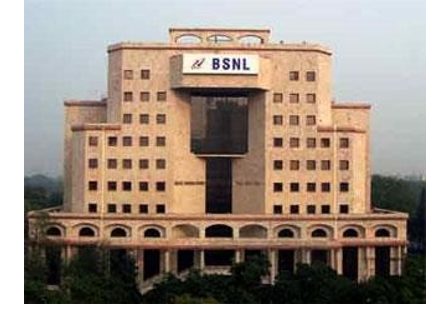
BSNL, formed on September 15, 2000, through the corporatization of the Department of Telecom Services, inherited its functions, excluding those in Delhi and Mumbai. The government, during corporatization, ensured BSNL's viability by offering measures to support its operations, even for socially desirable yet uneconomic services. BSNL is wholly owned by the Government of India, with an authorized share capital of Rs. 1,50,000 Crores and a paid-up capital of Rs. 38,886.44Crores, which will increase to Rs.2,10,000 Crores due to approved capital infusion. In FY 2022-23, its audited total income was Rs. 20,699 Crores. With expertise in planning, installation, and maintenance of telecom networks, BSNL also boasts a world-class ISO9000 certified Telecom Training Institute.
The telecom services provided by BSNL:
- Wire line Services: Traditional telephone connections for voice communication.
- GSM Mobile Services: Includes2G, 3G, and4 G networks for mobile communication. Offers a variety of value-added services (VAS) to enhance user experience.
- Internet and Broad band Services: Provide shigh –speed internet acces storesidentia land business customers. Offers Fiber to the Home (FTTH) technology for direct connectivity.
- Wi-Fi Services: Ensures seam less connectivity in public spacesan denter prises through Wi-Fi hotspots.
- Data Center Services: Supports the storage, processing, andmanagement of digit alinformationforbusinesses and organizations.
- Enterprise Data Services: Includes leased circuitsand MPLS VPN service stailored for corporate clients. Ensures secure and reliable connectivity for businesses.
- National Long Distance Services: Facilitates long-distance communication with in the country.
- International Long Distance Services: Enables individuals and businesses to stay connected a cross geographical boundaries.
Each of these services underscores BSNL's commitment to leveraging technology to provide comprehensive telecom solutions to its customers, addressing both traditional and modern communication needs
A. BSNL Vision
- To bethe Leading Telecom Service Provider in India
-
- BSNL aims to position itself as the premier telecom service provider in the country ,setting industry standards for reliability, coverage, and innovation.
- By continually enhancing its infrastructure, services, and offerings, BSNL seeks to solidify its market presence and emerge as the preferred choice for customers nationwide.
- Through strategic initiatives and investments, BSNL endeavors to expand its network reach and service capabilities, ensuring that it remains at the forefront of the telecom industry in India.
-
2. To be a Customer-Focused Organization with Excellence in Customer Care and Marketing:
-
- BSNL prioritizes customer satisfaction and loyalty by placing a strong emphasis on customer care and support.
- By adopting customer-centric practices and personalized marketing strategies, BSNL aims to engage with customers effectively, understand their needs, and delivertailored solutions.
- Through continuous improvement in its customer service processes and channels, BSNL endeavors to provide a seamless and responsive experience for its customers, building trust and loyalty over time.
3. Leverage Technology to Provide Affordable and Innovative Telecom Services/Products Across Customer Segments:
-
- BSNL recognizes the importance of technological innovation in driving affordability and differentiation in the telecom market.
- By harnessing the latest advancements in telecommunications technology, BSNL seeks to develop innovative products and services that address the evolving needs of diverse customer segments.
- Through cost-effective deployment strategies and efficient utilization of resources, BSNL aims to offer competitive pricing without compromising on quality or service standards.
- Additionally, BSNL remains committed to promoting digital inclusion by making its services accessible and affordable to all sections of society, contributing to the nation's socio-economic development goals.
B. Mission
- Becoming the Most Trusted Telecom Brand
-
- Strive to be the preferred and admired choice for customers nationwide.
- Focusondeliveringreliableservicesthatofferexcellentvalueformoney.
- Aimtogeneratevalueforemployees,shareholders,vendors,andassociates.
-
2. Excellence in Customer Service
-
- Provide friendly ,reliable ,and courteous customer service.
- Ensure timely and convenient assistance for customer inquiries and issues.
3.Tailored Products and Services
-
- Offer differentiated solution scattering to diverse customer segments.
- Develop a marketing culture responsive to evolving customer needs.
4. Profit ability and Asset Optimization
-
- Maximize return son existing assets through sustained profitability.
- Maintain a focus on operational efficiency and revenue enhancement.
C. Objectives
- Increase Sales Revenue*:
- Accelerate Mobile& Data Services Expansion
- Leverage Data Services for Growth
- Streamline Decision Making
- Develop Customer-Centric Marketing Team
- Enhance Customer Careand Service Quality
- Create Conducive Work Environment
- Optimize Asset Utilization
- Deploy Wi-Fi Hotspots and Upgrade Exchanges
- Expand Fiber Network with FTTH
- Suppor t National Development Initiatives
- Improve Workforce Productivity:
- Become Preferred Government Service Provider
- Explore International Telecom Opportunities
SNL offers a wide range of telecom services with advanced technology, serving a customer base of 1,079.77 Lakh subscribers. Here are the details:
- Wire Line Services:
BSNL operates a vast switching network with 20,920 exchanges, providing 163.29 Lakh lines to serve 65.36 Lakh customers.
2. Wireless Services:
-
- BSNL's cellular services cover cities, National Highways, Rail Routes, and State Highways, with 1,014.41 Lakh mobile connections against an equipped capacity of 1,142.94 Lakhs.
- It has 84,268 BTSs of 2G, 62,683 Node-Bs of 3G, and 8,638 e-Node-Bs of 4G technology.
- 3Gmobileserviceis availablein 6,283 cities/towns.
3. Broad band Services
-
- BSNL launched its broadband services in January 2005, offering wired broadband connections including DSL, FTTH, and ILL. As of May 31, 2023, it has 36.09 Lakh wired broadband connections.
- BSNL also provides Wi-Fi broad band connections, serving5.51 lakhunique users.
- Additionally, it offers wireless broadband services on 3G and 4G networks, with a total of 212.39 Lakh connections as of May 31, 2023.
4. Value Added Services(VAS)
BSNL provide savariety of Value Added Services to both landline and mobile customers, typically through third-party partnerships on a revenue-sharing basis.
III. LITERA TURE REVIEW
According to Aswathappa.K, a grievance can be defined as any feeling of discontent or dissatisfaction, regardless of whether it's expressed or not, and whether it's considered validor not. It arises from anything connected with the company that an employee perceives as unfair, unjust, or inequitable.
Features of a grievance include:
-
-
- It can be voiced or un voiced by the worker.
- It may be writtenor unwritten.
- It can be validor considere dridiculous.
- It may arise from something connected with the company.
-
The formal mechanism for addressing a worker's dissatisfaction is known as a grievance procedure. Procedures for resolving employee grievances may vary based on factors such as organizational structures, decision-making processes, or the size of the company. Large organizations typically have formal grievance procedures involving a series of steps.
Wyman (1971)In 1971, Wyman suggested that executives should provide a written solution to distressed subordinates regardingthe outcome of grievance resolution. He emphasized that unlike oral responses, written answers must adhere to established protocols set by management. Written responses should be devoid of any extraneous details and strictly focus on addressing the grievance.
Aprinted response is essential for grievance management as it serves as a record, particularly if the same issue arises in the future. Recorded grievance resolution results arealso necessary if the grievance is escalated to the next step in the grievance procedure, asper the Industrial Harmony Code for Conduct.
Karambayya and Brett (1989) Intheir1989research, Karam bayya and Brettidentified four roles that managers play in handling employee grievances.
- The first role is the cross-examining role, where managers retain control over both the process and outcome. They impose their own ideas, make final decisions, and enforce their own suggestions for the future.
- The second role is the meditational role, where managers ask employees questions about conflicts, solicit suggestions from them, and try to incorporate their ideas into proposed solutions.
- The third role is the technical organizer role, where managers designate the procedures for handling disputes and strictly enforce those rules.
- The fourth role is the motivational role, where managers rely on motivational control through the use of both fears and incentives. If disputes cannot be resolved during meetings, managers anticipate potential outcomes and apply pressure to encourage a timely settlement
Chaykowski & Slotsve, (1992); Tan, (1994). Ivancevich (2001)Chaykowski & Slotsve (1992) and Tan (1994), along with Ivancevich (2001), highlight that supervisors should handle grievances with care. They should gather all relevant facts, conduct thorough investigations, and provide responses. Once the grievance is resolved, managers should address any additional issues that may arise
Some of the studies regarding the grievance handling mechanism have been mentioned below:
- Grievance Handling Procedure in ITES Companies by M.R. Vidhya.
"Grievance Handling Procedure in ITES Companies" by M.R. Vidhya, any discontent or dissatisfaction experienced or perceived by an employee in a company, if not addressed properly, is considered a grievance. When employees join a company, they have certain expectations, and if these expectations arenot met over time, discontent arises, which can manifest as grievances if not handled effectively. No company is entirely free from grievances, but every company should have a proper mechanism for addressing them. Grievances serve as upward communication, alerting management to potential problems in advance. Grievances can be real or imagined, valid or invalid, genuine or false. Addressing employee grievances is crucial as they can lead to unhappiness, frustration, low morale, and negatively impact production.
2. Effectiveness of Grievance Handling procedures-“A study of Bhilai Jaypee Cement limited” byMs. Madhavi Sukhdani
Jai Prakash Associates Limited (JAL) and Steel Authority of India Limited (SAIL) entered into a Shareholders Agreement on March 21st, 2007, marking thelargest joint venture between SAIL and a private corporation. Under this agreement, SAIL would contribute 26% of the total equity, with the remaining 74% being contributed byJAL. The joint venture company ,named "BHILAIJAYPEECEMENT LIMITED"(BJCL), was incorporated on April 11th, 2007, in collaboration with Steel Authority of India Ltd. (SAIL), aiming to produce 2.2 MTPA of cement in Bhilai & Satna.
Theemployeestrengthfortheclinkerisationplantwas400. Inlarge organizations like this, where there are numerous personnel across various levels, it becomes challenging for managers to monitor each individual or be involved in every aspect of the work. Therefore, having a grievance procedure in place is essential. The primary value of a grievance procedure lies in its ability to minimize discontent and dissatisfaction, which can have adverse effects on cooperation and productivity. This paper aims to study the effectiveness of the grievance handling procedure at Bhilai Jaypee Cement Limited.
IV. GRIEVANCEHANDLINGMECHANISM
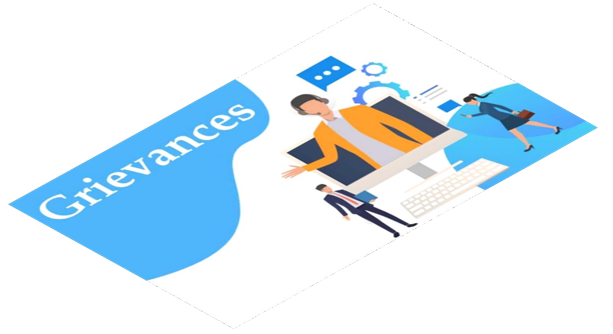
A grievance is any dissatisfaction or feeling of injustice having connection with one?s employment situation which is brought to the attention of operation. Speaking astronomically, a grievance is any dissatisfaction that negatively affects organizational relations and productivity. To understand what a grievance is, it's necessary to distinguish between dissatisfaction, complaint, and grievance
- Dissatisfactionisanythingthatdisturbsanhand,whetherornottheuneasinessisexpressed in words..
- Complaint is a spoken or written dissatisfaction brought to the attention of the supervisor or the shop steward.
- Grievance is a complaint that has been formally presented to a operation representative or to a union functionary.
According to Michael Jucious, „ grievance is any disgruntlement or dissatisfaction whether expressed or not, whether valid or not, arising out of anything connected with the company which an hand thinks, believes or indeed feels to be illegal, unjust or inequitable In short, grievance is a state of dissatisfaction, expressed or unexpressed, written or unwritten, justified or unjustified, having connection with employment situation.
A. Features Of Grievances
The crucial features of grievances are
- Complaints: Grievancesgenerallyinvolvecomplaintsordissatisfactionexpressedby individualities or groups.
- FormalorInformal:Grievancescanberaisedformallythroughsanctionedchannels within associations or informally through exchanges or emails.
- Conflict: Grievances frequently arise due to conflicts between individualities, departments, or operation and workers.
- Resolution: The thing of addressing grievance sis to find are solution that satisfies the concerned parties and improves the situation.
- Documentation: Grievances may need to be documented for legal or record-keeping purposes.
- Feedback: Addressing grievances provides organizations with valuable feedback on areas that need improvement.
- Procedures : Many organizations have specific procedures in place for handling grievances, outlining steps to be taken and individuals responsible for resolution.
- Communication :Effective communication is crucial in addressing grievances to ensure all parties understand the issues and potential solutions.
- Prevention: Proactive measures can be taken to prevent grievances from occurring, such as creating a positive work environment and providing avenues for feedback and discussion.
- Resolution Time frame: Grievances should ideally be resolved in a timely manner to prevent escalation and maintain trust within the organization.
B. Causes Of Grievances
Grievances may occur due to a number of reasons:
- EconomicReasons:Employeesmightdemandhigherwages,feelunfairlytreated regarding bonuses or overtime pay, or perceive inequalities in pay compared to others.
- Work Environment: Grievances can arise from poor working conditions like inadequate lighting, space, or equipment, as well as unfair rules or lack of recognition.
- Supervision: Employees may object to their supervisor's attitudes, feeling biased, favoritism, or discriminated against due to factors like caste or regional affiliations.
- Organizational Changes: Grievances can stem from changes in company policies or practices, causing discomfort or dissatisfaction among employees.
- Employee Relations: Issues like conflicts with colleagues, feelings of neglect, or victimization can lead to grievances.
- Miscellaneous: Other grievances may involve violations related to promotions, safety, transfers, disciplinary actions, leaves, or medical facilities.
C. Effects of Grievances
Grievances, if not identified and redressed, may adversely affect workers, managers, and the organization.
The effects are the following:
- On Production
-
- Poor qualityof output
- Decreased productivity
- More material wastage and machinery damage
- Higher production costs perunit
-
2. On Employees
-
- More absent eeismandturnover
- Reduced commitment ,sincerity ,and punctuality
- Increase daccidents
- Lowermoraleamong employees
3. On Managers
-
- Strained relationships between managers and subordinates
- Increased need for supervision and control
- More cases of indiscipline
- Risingun rest, necessitating measures to maintain industrial peace
D. Types of Grievances
- Economic Grievances: Related to wages, bonuses, overtime pay, or perceive dine qualities in compensation.
- Work Environment Grievances: Stemming from poor working conditions such as inadequate facilities, equipment, or safety measures.
- Supervision Grievances: Arising from issues with the behavior or actions of supervisors, such as favoritism, bias, or unfair treatment.
- Organizational Policy Grievances: Concerning changes in company policies, procedures, or practices that affect employees negatively.
- Interpersonal Grievances: Resultingfromconflictsordisputesbetweenemployees, including harassment, discrimination, or bullying.
- Disciplinary Grievances: Involvingdisputesoverdisciplinaryactionstakenagainstemployees, such as warnings, suspensions, or terminations.
- Promotional Grievances: Relatedtoissueswithpromotions,demotions,transfers,or career advancement opportunities within the organization.
- Miscellaneous Grievances: Covering a range of other issues such as leave policies, medical benefits, training opportunities, or workload distribution.
E. Grievance Handling Process
A grievance procedure is a way for employees to address their concerns internally. It's often included in collective bargaining agreements and involves steps to resolve disputes.
Here's how it typically works:
- Initiation: Employees bring their grievance to their immediate supervisor, either informally or formally using a written grievance form. This must usually happen within a specified timeframe after the incident.
- Review: The supervisor and union representative assess the grievance to determine its validity. Three outcomes are possible: no valid grievance, resolution, or escalation to the next step.
- Escalation: If unresolved, the grievance moves up the company hierarchy, often involving higher-level supervisors and union representatives.
- Arbitration: If the grievance remains unresolved, an outside arbitrator maybe brought in. This typically involves senior leaders from both sides.
An effective grievance procedure provides a way for employees to address concerns, potentially preventing serious issues or legal action.
a. Three possible outcomes may occur at this stage of the process
At this stage of the process, three outcomes are possible:
-
-
- The supervisor and union representative may find no valid grievance.
- The grievance may be resolved satisfactorily.
- Ifnotresolvedtotheemployee?ssatisfaction,itadvancestothenextstep.
-
The next step involves the next level of supervisor. In most union environments, the employee is represented by the union and is not present. If unresolved, it moves to a higher level of company management and potentially a higher-level union representative.
If still unresolved at the highest levels, an outside arbitrator may be called in. This typically involves senior leaders from both sides.
An effective grievance procedure provides a mechanism for employees to resolve concerns, potentially preventing serious issues or litigation.
b. Need for a Formal Procedure to Handle Grievances
Agrievancehandlingsystemservesasanoutletforhandfrustrations,discontents,andgripes like a pressure release value on a brume boiler. workers don't have to keep their frustrations bottled up until ultimately disgruntlement causes explosion. The actuality of an effective grievance procedure reduces the need of arbitrary action by administrators because administrators know that the workers are suitable to cover similar gest and make demurrers to be heard by advanced operation. The very fact that workers have a right to be heard and are actually heard helps to amelioratemorale. In view of all these, every association should have a clear- cut procedure for grievance running.
F. Grievance Handling Procedure
Under two common types of grievance procedures:
- Open Door Policy
In an open door policy, employees are encouraged to bring their grievances directly to higher levels of management without any formal barriers. This approach promotes transparency and accessibility, allowing employees to discuss their concerns with supervisors, managers, or even top executives.
2. Step-Ladder Policy
In a step-ladder policy, grievances are addressed through a structured series of steps. Typically, employees must first discuss their concerns with their immediate supervisor. If the issue remains unresolved, they can escalate it to higher levels of management, following a predetermined hierarchy or ladder of authority. This approach ensures that grievances are addressed systematically and progressively.
G. Five Steps To Use To Conduct A Grievance Procedure In A company
To conduct a grievance procedure effectively, follow these five steps:
- Step#1: Raise the grievance verbally
Encourage employees to first raise their grievance verbally to see if it can be resolved. This step is suitable for minor incidents that can be resolved through discussion, such as disagreements or minor conflicts. However, it's important not to insist on resolving serious matters informally, as it may be seen as disrespectful to the employee.
2. Step#2: Lodge a written complaint
Advise your employee to lodge a written complaint. It's essential to support your employee throughout this process. As a manager, showing emotional intelligence means being able to encourage grievances without taking them personally. Remember, having grievances is natural in any workplace; it's how you manage them that matters.
During the induction phase and when an employee raises a grievance, guide them through the process and explain how to complete the grievance form effectively. The complaint should include:
-
-
- The factual basis of the grievance
- The individual(s) against whom the grievance is lodged
- The date and time of the incident
- The specific company policy or employee action that's allegedly violated
- The desired resolution or solution sought
-
Encourage the employee to provide as much detail as possible, including dates, times, people involved, and a precise description of the incident. This thoroughness will help in addressing the grievance effectively.
3. Step#3:Investigatethe grievance
This process can occur either with both parties present (the grievant and the accused) or through separate investigations. After investigating, it's crucial to bring both parties together for a discussion. Your mediation skills are key in resolving the issue effectively.
-
-
- During the discussion:
- Listen to both parties attentively.
- Maintain a neutral role throughout.
- Stresstheneedforabusiness-orientedsolution,emphasizingthatbothpartiesmust resolve the matter for the benefit of the business.
- Guide the conversation towards finding a satisfactory resolution that allows both parties to return to work.
- If a work rule has been violated, consider referring the matter to a disciplinary enquiry.
- Aim to resolve the issue promptly, usually within three to five days.
-
4. Step#4:Hold a grievance hearing
-
- Hold a grievance hearing with both parties present, allowing each to present their side of the story. Listen carefully to understand what will resolve the matter, as the complainant often seeks an apology.
- Ensure to provide an outcome within the timeframe specified in your company's grievance procedure ,typically within three to five days. Delaying the resolution can lead to distraction and decreased productivity.
- Ifunabletomeetthestipulatedtimeframes,informthegrievantandextendtheperiod while actively working towards resolution.
5. Step#5: Lodge further grievances with senior management
-
- Your policy should include provisions for the next steps if the grievant is not satisfied with the response or if the matter remains unresolved within the specified time frame. If you are the subject of the grievance, the next step typically involves referring the matter to the next level of management. This step should also have a timeframe, usually between three to five days.
- Following these steps will enable you to conduct an efficient grievance procedure.
H. Grievance Procedure In Indian Industry
The15th session of the Indian Labor Conference in 1957 highlighted the necessity of an established grievance procedure acceptable to both unions and management. In the subsequent 16th session, a model for a grievance procedure was formulated, aiding in the creation of grievance machinery. This model outlines specific steps to be followed for addressing grievances:
- Step 1: The grievance is submitted to the departmental representative, a management representative, who must respond within 48 hours.
- Step 2: If the departmental representative fails to resolve the issue, the aggrieved employee can escalate it to the head of the department, who must provide a decision within 3 days.
- Step3:Ifstillunsatisfied,theemployeecantakethegrievancetotheGrievanceCommittee. The Committee then submits its recommendations to the manager within 7 days. The final decision of the management, based on the Committee's report, must be communicated to the employee within three days If the grievance remains unsettled:
- Step 4: The case may be referred to voluntary arbitration, a binding adversarial dispute resolution process where parties choose arbitrators to render a final decision after a hearing. Key elements include voluntary submission of disputes and attendance of witnesses.
I. Grievance Redressal Mechanism under Industrial disputes Act
The objective of the Industrial Disputes Act 1947 is to secure industrial peace and harmony by providing machinery and procedure for the investigation and settlement of industrial disputes by negotiations. This act deals with the retrenchment process of the employees, procedure for layoff, procedure and rules for strikes and lockouts of the company.
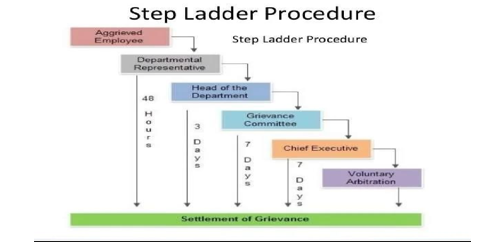
V. RESEARCH/EXPLORATIONMETHODOLOGY
Research/Exploration is defined as a" careful disquisition or inquiry, especially through the hunt for new data in any branch of knowledge.
A project, on the other hand, is a systematic presentation that includes a formulated hypothesis, collected data, analysis of the facts, and proposed conclusions presented in the form of recommendations.
A. Kind of Research
The research conducted is descriptive research, which focuses on describing situations rather than making predictions or determining cause and effect.
In survey method research, participants respond to questions either through interviews or questionnaires. Researchers then describe the responses provided. To ensure the reliability and validityof the survey, it's crucial that questions are constructed properly. They should be clear and easy to comprehend for participants.
B. Research Design
The research design refers to the method and procedure specified to acquire the information necessaryto address orsolveaproblem. It encompasses the overall operational framework of the project, outlining what information is to be collected from which sources and through whatprocedures.Theresearchdesignarrangesconditionsfordatacollectionandanalysisina manner that aims to balance relevance to the research purpose with efficiency in procedure.
C. Data Analysis
The data analysis was based on units, age, years of experience, and various factors. Simple average method was used for analysis to ensure that the survey findings are easily understandable by all.
Method of Data Collection:
The researcher opted for the questionnaire method due to time constraints. When designing the data collection procedure, measures were taken to ensure safe guards against bias and unreliability. Thecollecteddatawereexaminedforcompleteness,comprehensibility,consistency,andreliability.
Additionally, secondary data were gathered from sources such as journals, historical documents, magazines, and reports prepared by other researchers. The following methods were used for the present research: Questionnaires Interviews Observation
D. Sampling And The Method Used
Sample Design: Care was taken to select the sample based on considerations such as age, sex, and work experience of respondents to ensure better representation of the heterogeneous population. However, the sample design was that of "convenience sampling" or "haphazard sampling" only.Timeconstraintsandthesizeofthepopulationweremajorfactorsindeterminingthe choice of sample design.
Sample Size: Asamplesizeof50.Questionnaireswererandomlyadministeredtoemployees from different units.
Statistical Tools Used: Thestatisticaltoolsthatisbeingusedfordatacollectionandanalysisinclude: Pie Charts Tables
E. Methodology
-
- Everyprojectreliesonaspecificmethodology,whichsystematicallyguidesthe problem-solving process or achievement of its objectives. According to Clifford Woody, Research Methodology involves defining and redefining problems, collecting, organizing, and evaluating data, making deductions, and arriving at conclusions.
- The methodology used in this project follows these steps:
- Defining the objectives of the study.
- Developing a questionnaire aligned with the objectives.
- Gathering feedback from employees.
- Analyzing the feedback.
- Drawing conclusions, presenting findings, and providing suggestions based on the analysis.

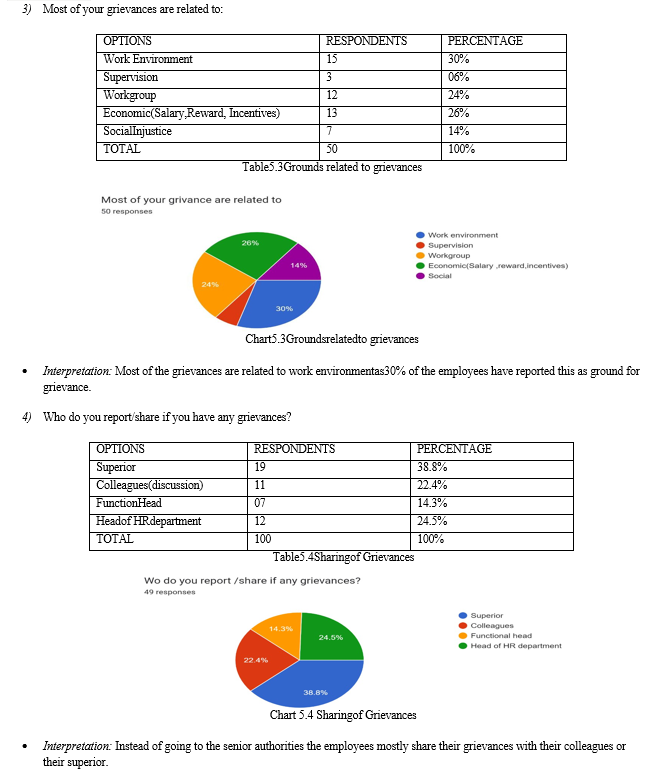


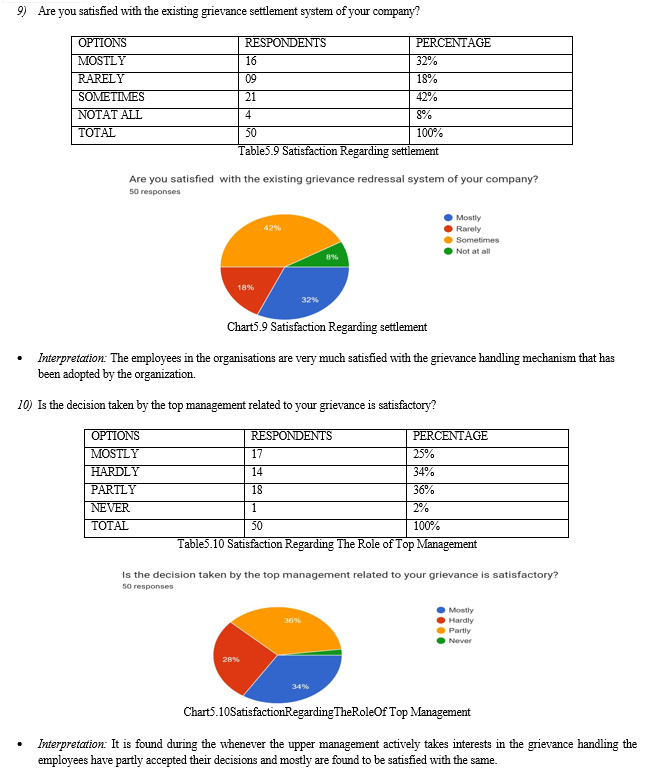
VII. FINDINGS AND SUGGESTIONS
A. Findings
- Most of the employees find that the work culture in the organization is very much supportive. But at times they face grievances which are mostly related to salaries, incentives and the work environment.
- The employees discuss their grievances with their superior rather than the HR head. Also the grievances are taken care off most of the times.
- Majorly the problem relies with the superior who takes decision according to level of Greivances and take in defined time to reply to the grievances reported to them. Also the management participates in the grievance handling only to a certain extent when the situation goes out of reach of the senior managers.
- The employees aren't much satisfied with the grievance handling ,they get satisfied sometimes only and also feel that the management participate actively in the same.
- Employees find that the informal way to solve their problems proves out to be more suitable. Also that their grievances actual basis is not found out but yes the seniors listen to them actively.
- The grievance handling system is faulty as the employees aren't continuously informed the progress of their grievance handling but yes the seniors try to solve the problems verbally and create a healthy environment.
- The employees do not seem to be satisfied with the decisions taken regarding their grievances as there is not much follow ups post decision making.
- Also the committee set-up to solve the problems does not actively participates to solve the problems.
B. Suggestions
Fortheeffectiveworkingoftheorganisationthecompaniesshouldconsiderthe following:
- Training on Communication, body language(concerning behavioral aspects)
- Education and training on Employee Morale.
- AwarenessprogramregardingtheESIandPFbenefits,variouslaborlawsand employee welfare schemes.
- DiscussionontheVisionandMissionstatementsofthecompanyandthewaysto achieve.
- More clarity on roles and responsibilities to be carried out by individuals (Duties and rights).
- Education on Occupational safety.
- Awareness on importance of education.
- Employees participation, suggestion, ideas need to be encouraged by the supervisor which will surely motivate the employees and will result in higher level of job satisfaction. This cannot be done immediately and it will not be encouraged by all employees suddenly, it will take time to be involved. Still it is very good for the employees as well as the company.
- A system of suggestion box can be implemented which will facilitate the employees to give their suggestion to improve the organization and the performance of the employees as well.
- Since most of the employees in production and manufacturing level are uneducated open door sessions can be carried out so that they will feel easy to express their problems.
- Time barrier must be fixed to solve problem at different levels which will encourage the employees to express their grievance.
- The problems should be solved considering their importance, urgency and implications.
- Counselling of employees need to be carried out periodically which will help the organization to the problem of employees and to solve them which will increase the job satisfaction as well as increase in the efficiency of the employees.
- Informal counseling helps to address and manage grievances in the workplace.
- The management can interact well with the employees whenever there is a problem or grievance. This will make the employee to explain the problem properly. This should be done with no perceptions and no favor.
- Job descriptions, responsibilities should be as clear as possible. Everyone should be informed of company’s goals and expectation including what is expected from each individual.
VIII. ACKNOWLEDGEMENT
Any accomplishment requires the effort of many people and this work is no exception. I would like to thank Ms. Dr. Pratibha Varma (Assistant Professor, GU) for providing me all the necessary guidance for carrying out this research report. Her valuable guidance and encouragement have really led me to the path of completion of this report.
These words of thanks are just a token of my true appreciation for all who have supported me to give this report its shape.
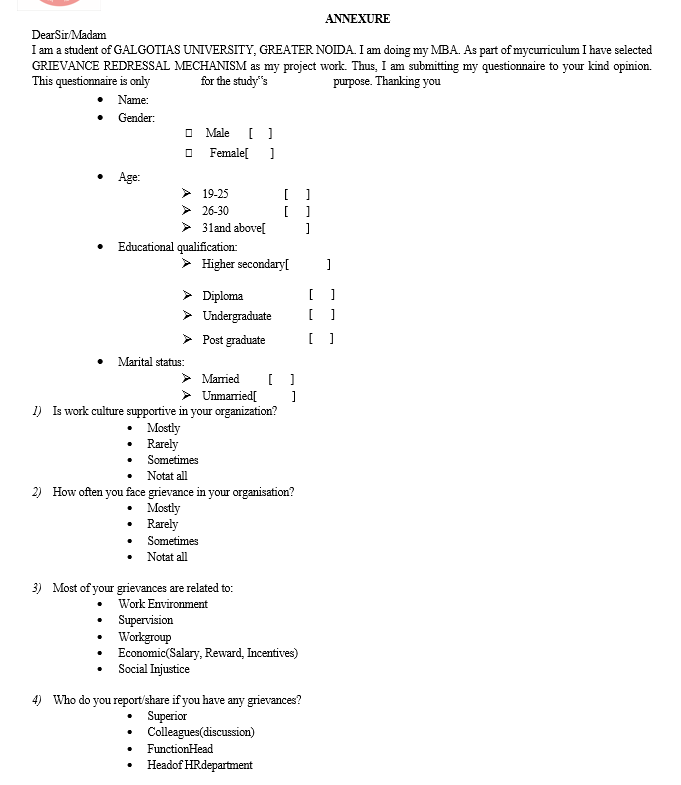
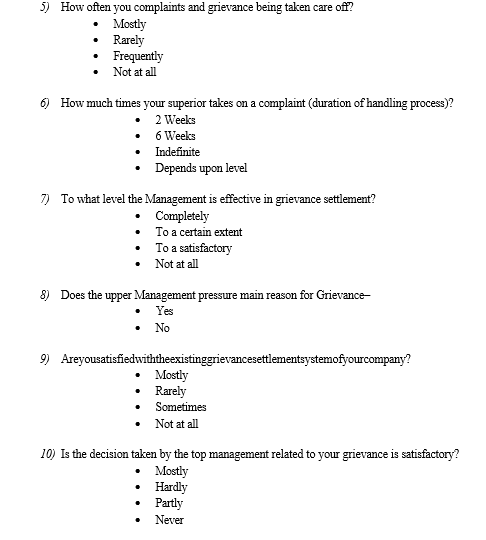
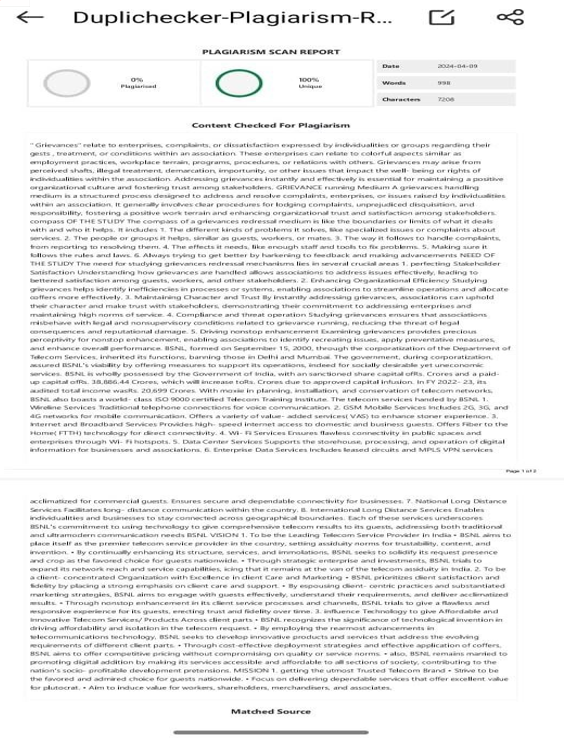
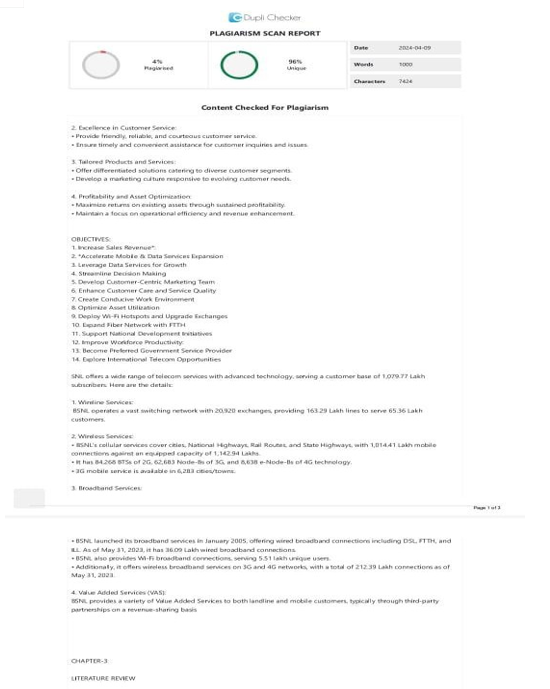
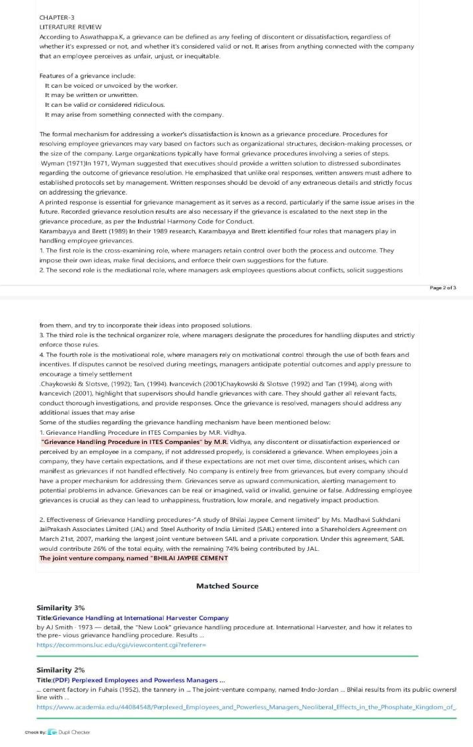
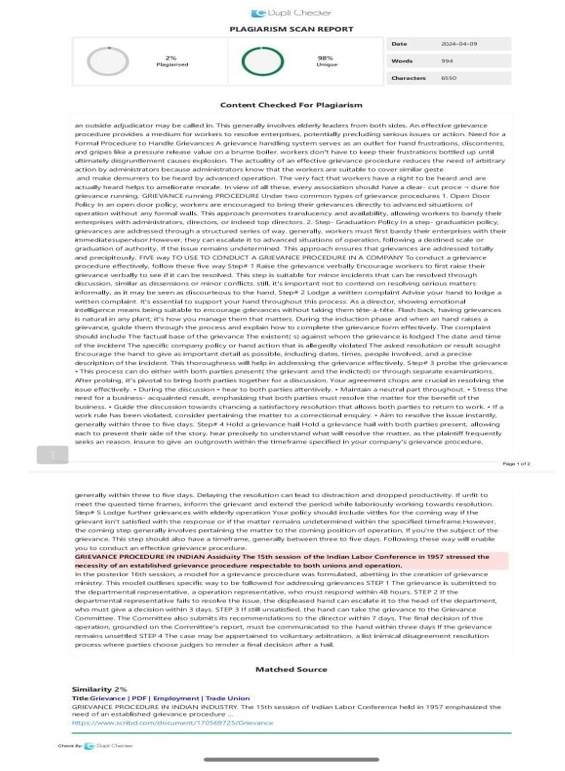
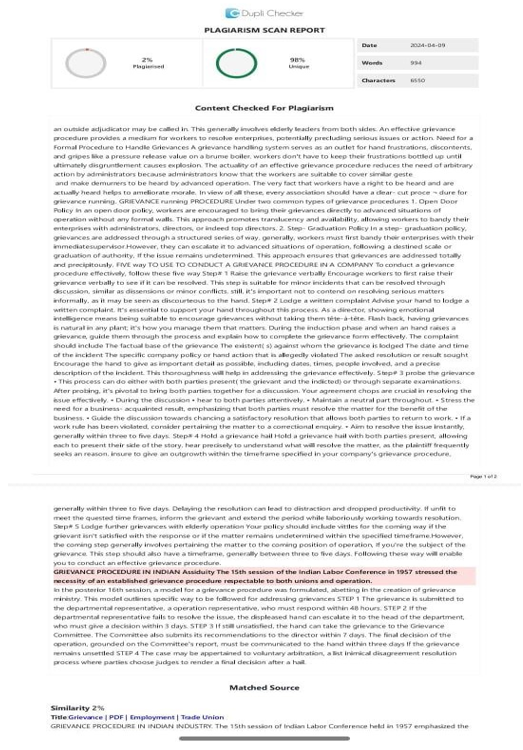
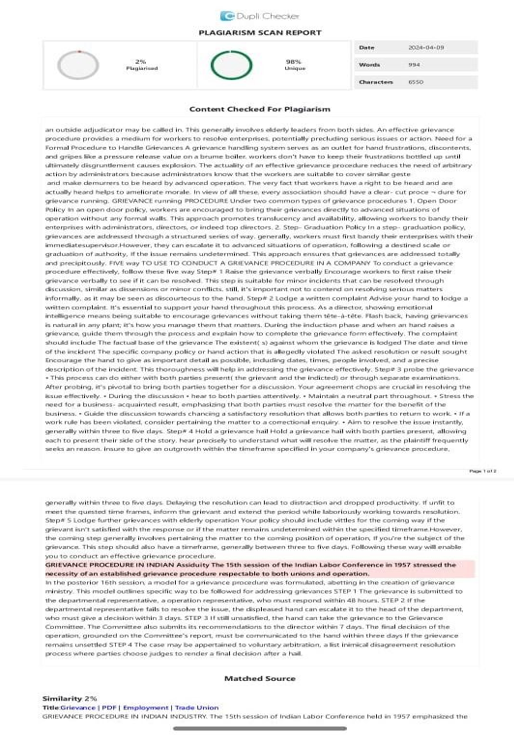
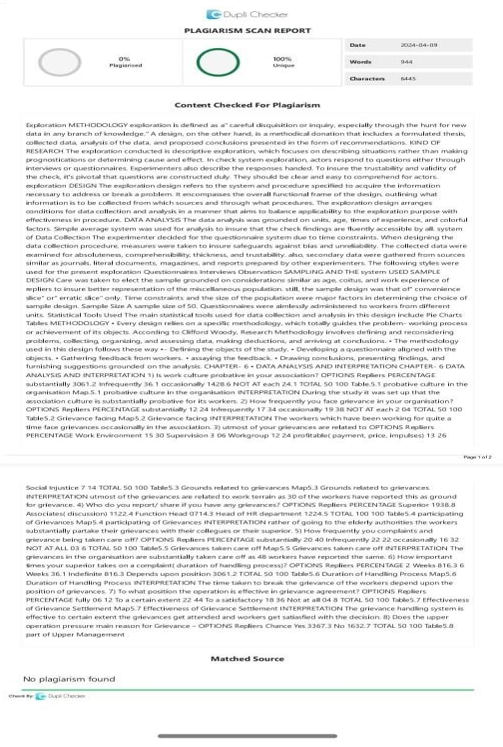
Conclusion
Grievance procedures are related to other attitudinal measures and the actions of shop servants in the grievance procedure It\'s procedures have been set up to relate to union commitment, employer commitment and binary commitment. The grievance procedure provides a means for relating practices, procedures, and executive programs that are causing hand complaints so that changes can be considered still, the operation platoon comprising of the CEO, applicable Heads of Department( Jugs), If the organization is unionized. This is needed contractual obligation because when an employer recognizes a union, it acknowledges that the union represents all workers within the compass of the collaborative agreement. Communication with the workers can be carried out through notices or leaflets, followed up staff meetings for the purposes of carrying feedback, addressing enterprises and furnishing assurances. In a unionized organization, the operation should accept the Trade Union’s backing in communication because generally, workers are more open to communication from the Trade Union. Administration should insure that the grievances should be entered and stable instantly, so that the workers get the necessary intelligence of satisfaction. As former stated, redressal of the grievances is a must to save good labor operation relations and artificial peace. therefore, the operation should certify that the grievance should be entered and settled instantly, so that the workers get the essential sense of satisfaction. The worried hand approaches the frontal line administrator first. However, a representative of trade union also links the administrator in handling the grievance, If the concern is unionized. All grievances cannot be resolved in this step, as these may be beyond the authority and capability of the director. In the coming step, the mid-level director, generally the labor force officer, along with amid-union officer attempt to attack the grievance. In the third step, the top administration and top union leaders be seated together to settle grievances concerning company wide issued. However, it\'s appertained to an external adjudicator for redressal, If the grievance keeps on unsettled.
References
Websites [1] https://www.lawteacher.net/free-law-essays/employment-law/grievance-redressal-mechanism-under-industrial-disputes-act-employment-law-essay.php [2] https://www.ijcrar.com/vol-2-8/M.J.Arputharaj%20and%20R.%20Gayatri.pdf [3] https://sites.google.com/site/whatishumanresource/the-employee-state-insurance-act-esi-1948 [4] https://sites.google.com/site/whatishumanresource/the-industrial-disputes-act-1947 [5] http://www.theweekendleader.com/Causes/1270/maruti-mire.html [6] http://newsclick.in/node/2616 Books [1] “Human Resource Management” by Ashwathapa. [2] “Human Resource Management” by Michael Armstrong. [3] “HumanResourcePolicyAnalysis:OrganizationalApplications”byRichardJ. Niehaus. Journals [1] Employee Grievance Redressal Procedure in Indian organizations, Dr. Nilesh Thakre, IJRCM, 2013, Vol 3 (4), pg 98-102. [2] Pawan Kumar Taneja and Singh P.P, (2004).Capital Market Reforms- A Case Study of Grievances and Awareness of Retail Investors in Stock Market. New Delhi: Deep and Deep Publication. ISBN: 81-7629-724-0, 20-30. [3] Himanshu Rai (2008).Disputes and Dispute Resolution: The Effect of Union Density on Employee Intention to Quit - An Indian Study. MANAGEMENT AND LABOUR STUDIES Vol. 33 No.2, May, 2008. [4] M.R. Vidhya (2012), Grievance Handling Procedure in ITES Companies, IOSR Journal of Humanities and Social Science (IOSR-JHSS) e-ISSN: 2279-0837, p-ISSN: 2279-0845.PP 61- 65.
Copyright
Copyright © 2024 Sonal Tripathi. This is an open access article distributed under the Creative Commons Attribution License, which permits unrestricted use, distribution, and reproduction in any medium, provided the original work is properly cited.

Download Paper
Paper Id : IJRASET61108
Publish Date : 2024-04-27
ISSN : 2321-9653
Publisher Name : IJRASET
DOI Link : Click Here
 Submit Paper Online
Submit Paper Online

